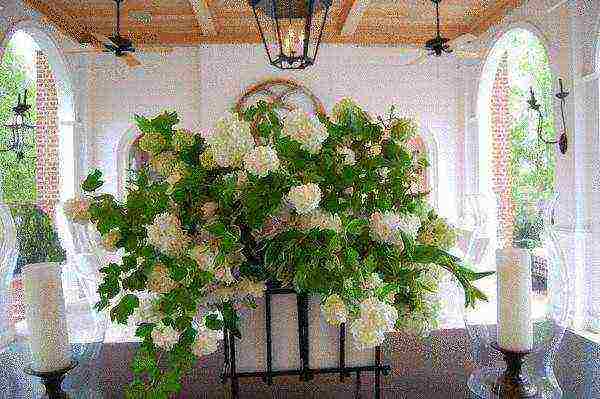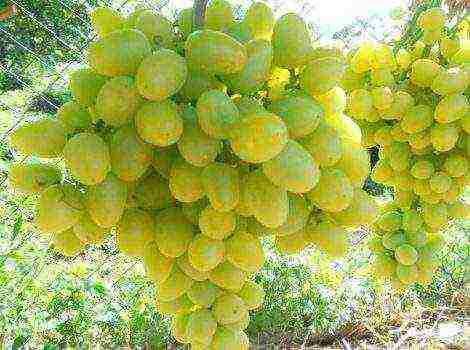Content
- 1 Viburnum varieties for the north
- 2 Viburnum varieties for central regions
- 3 Viburnum varieties for the southern regions
- 4 Vigorovskaya
- 5 Maria
- 6 Ulgen
- 7 Red Bunch
- 8 Zholobovskaya
- 9 Kalina avabuki
- 10 Kalina Barkwood
- 11 Kalina bodnantskaya
- 12 Kalina gordovina
- 13 Kalina David
- 14 Viburnum fragrant
- 15 Kalina Karlsa
- 16 Viburnum cinnamon-leaved
- 17 Viburnum large-headed
- 18 Viburnum laurel, or evergreen
- 19 Viburnum wrinkled
- 20 Viburnum ordinary
- 21 Kalina useful
- 22 Viburnum folded
- 23 Kalina Farrera, or fragrant
- 24 A few facts about viburnums that you did not know yet:
- 25 Placement of viburnum in the country
As you know, viburnum is a medium-sized shrub or small tree that bears fruits that ripen in late August or September. They are scarlet in color with juicy pulp and a very large seed inside. These berries are used in cooking, for medicinal purposes, they are eaten both processed and fresh.
Viburnum berries
In Russia, viburnum has been known for a long time, it is ranked among the primordially Russian cultures along with mountain ash and birch. Real breeding work began in our country with viburnum only at the end of the twentieth century, that is, relatively recently.
The very first varieties of viburnum appeared in the State Register of Breeding Achievements in 1995, only 22 years ago, they are relevant to this day, these are cultivars: Zholobovskaya, Souzga and Ulgen. The newest variety was included in the State Register in 2016; this is the cultivar Aurora. In total, at the moment, 14 varieties of this wonderful culture are included in the State Register.
It is interesting that the viburnum does not have a strict gradation by region; it is a universal culture with a set of properties that allow one or another variety to be successfully grown in regions that are completely different in terms of climatic characteristics. It is conditionally possible to divide the viburnum varieties available in the State Register into three large groups - those varieties that are more suitable for the northern regions, because they are highly winter-hardy; varieties that give the best yields in the center, with its longer than in the north, a warm period and plenty of moisture; and varieties that will yield record yields only in the south, where droughts are not uncommon. As a result, six varieties can be distinguished and recommended for the northern regions and four varieties each - for the center of Russia and the south of the country.
Viburnum varieties for the north
Let's start with the northern regions, here varieties such as Zarnitsa, Shukshinskaya, Vigorovskaya, Zakat, Maria and Ryabinushka will feel better.
Viburnum variety Zarnitsa, - ripens in early September, the fruits are bitter, so it is better to process them. The plant looks more like a tree than a bush, forms up to five skeletal branches, gives little growth. The fruits are arranged in an umbrella-shaped scutellum, they are not very large, about 0.65 g, the shape is ellipse, the color is light red. Fruits contain up to 8% sugars, more than 110 mg% ascorbic acid and anthocyanins. Tasters rate the taste of this variety at 3.6-3.8 points out of five. The variety is distinguished by the highest winter hardiness and a fairly good yield - about four kilograms of fruits per plant.
Viburnum Shukshinskaya, - this variety ripens in early September. Outwardly, this bush (not a tree) has up to six skeletal branches and grows quite actively. The leaf blades are light green, turn purple closer to autumn. The fruits are arranged in an umbrella-shaped scutellum, they have a spherical shape and a mass of about 0.55 g. The color of the berries is crimson-scarlet, the taste is good, but the bitterness is noticeable.Fruits contain up to 10% sugars, more than 55 mg% ascorbic acid, anthocyanins. The variety is highly winter-hardy, partially self-fertile and reproduces well with green cuttings. The yield is about three kilograms per plant.
Viburnum Vigorovskaya, - this variety is obtained from crossing Taiga rubies and Ulgeni. The fruits of the variety ripen closer to mid-September. Plants of the variety are shrubs with three to five skeletal branches and reaching a height of three meters. The fruits are arranged in umbrella-shaped scutes. The leaves are green with pronounced lobes. Fruits have the shape of a ball, their mass is from 0.51 to 0.53 g. The pulp of berries with an abundance of juice, which contains up to 13.9% of sugars, slightly more than 1.5% of various acids of which up to 45 mg% of ascorbic acid. The taste of the berries is very pleasant, the bitterness is practically not felt, the taste is rated by tasters at 4.3 points, which is a very high indicator for viburnum. The plants themselves are highly winter-resistant and productive (about five kilograms per plant).
Kalina grade Zarnitsa
Viburnum variety Sunset, - the fruits of this variety are ready to be harvested in early September, they taste very bitter, and therefore are suitable only for processing. Plants are shrubs with straight shoots, rather vigorous. Ripe berries, for viburnum, are rather large, about 0.72 g, their shape is round, fully ripe, they acquire a rich scarlet color. The yield is very high - more than seven kilograms per bush. The variety is highly winter-hardy, resistant to pests and diseases.
Viburnum Maria, - the berries of this variety can be picked at the very end of August, the fruits are quite pleasant to the taste, there is bitterness, but it is unobtrusive, so the berries can be eaten fresh or put into processed products. Plants of the variety are shrubs with a slightly spreading crown. The leaf blades are very large and green. The fruits are medium in weight, usually from 0.61 to 0.63 g, their shape is round, when fully ripe, they become light scarlet. The yield is quite high - up to ten kilograms per adult plant. This variety is highly winter-resistant, is not affected by diseases, from pests only sometimes it is attacked by aphids.
Ryabinushka, - this variety was obtained by simple selection among viburnum seedlings near the Bogataya River. As a result, a variety was obtained, the fruits of which ripen at the very beginning of September, but do not have a good taste, they are noticeably bitter. The plant of the variety is a very sprawling bush with large leaf blades of a dark green color. The fruits of the variety have an oval shape, a rather dense skin, they are devoid of a "viburnum" aroma, unpleasant for many; the berries are quite large, more than nine kilograms of harvest can be harvested from one adult plant. The variety is highly winter-hardy and just ideal for growing in the northern regions.
Viburnum variety Sunset
Viburnum varieties for central regions
In the center of Russia, such varieties as Zholobovskaya, Souzga, Ulgen and Taiga rubies will show themselves better in terms of yield and marketability of berries.
Viburnum variety Zholobovskaya, - obtained by selection among viburnum seedlings in the wild. The fruits are ready to be harvested in mid-September. Plants of this variety are shrubs with a very compact crown. When planted in two years, the first fruits can be obtained in the third or fourth year. The berries are collected in an umbrella-shaped scutellum, they are slightly elongated and have a spherical shape and a bright red color. The average weight of the berry is about 0.58 g, each has a rather juicy pulp with a barely perceptible bitterness, we can say that the fruits are sweet. The tasting score is about 4.1 points, which is a very good indicator for viburnum. Each viburnum fruit contains up to 18% dry matter, more than 11% sugars, about 1.5% acids, up to 115 mg% ascorbic acid and over 715 mg% P-active compounds. The maximum yield of the variety is about five kilograms per bush. Alas, the variety requires pollinators and needs additional watering.
Viburnum Souzga, - the variety is obtained by selection among wild-growing seedlings of viburnum. The fruits ripen towards the end of September. Plants of this variety are rather compact bushes, giving the first harvest 3-4 years after two-year-olds are planted on the site. The berries are arranged in an umbrella-shaped scutellum, they are spherical and deep red in color when fully ripe. The average fruit weight is about 0.66 g, they all have a juicy pulp, with a barely noticeable bitterness. The taste is rated by tasters at 3.7-3.9 points. Each fruit contains up to 10% sugars, about 1.9% acids, more than 137 mg% ascorbic acid and over 580 mg% P-active compounds. The maximum yield reaches 6.6 kg per bush. Alas, the variety is self-fertile, requires pollinating varieties on the site and needs additional irrigation.
Kalina grade Zholobovskaya
Viburnum variety Ulgen, - this variety was obtained by selection among seedlings that grew in nature. The fruits ripen around mid-September. Plants of this variety are shrubs with a compact crown and begin bearing fruit for 3-4 years, when planted in two years. The berries are arranged in an umbrella-shaped scutellum, they have a spherical-elliptical shape and a deep red color. The average weight of a berry is about 0.69 g, each has a juicy pulp with a slightly bitter aftertaste. The taste is estimated by the tasters at 4.1 points. Each fruit of this variety contains up to 12.5% sugars, about 1.9% acids, more than 129 mg% ascorbic acid and up to 560 mg% P-active compounds. The maximum yield per bush is about four kilograms. Alas, the variety is self-fertile, requires pollinating varieties on the site and needs additional irrigation.
Viburnum Taiga rubies, - this variety was obtained by selection among seedlings from free pollination of Viburnum vulgaris. The fruits ripen closer to the beginning of September. Plants of the variety are typical shrubs, reaching a height of three meters and having a crown of the same diameter as the height of the plant. The fruits are arranged in an umbrella-shaped scutellum, they have a spherical shape and reach a mass of 0.51 g. Each berry contains up to 9.6% sugars, more than 1.5% acids, about 130 mg% ascorbic acid and up to 668 mg% P-active connections. The taste is bitter, but the sweetness is also felt, so the tasters rate the taste at 3.4-3.6 points. The variety reproduces well with green cuttings, gives a yield of about three kilograms per bush and requires additional watering.
Viburnum grade Taiga rubies
Viburnum varieties for the southern regions
For the south, varieties that are moderately demanding on moisture are also suitable, withstanding small dry periods and in such conditions capable of giving high yields, these are: Red Bunch, Elixir, Pomegranate Bracelet and Aurora.
Viburnum Red bunch, - the fruits ripen around the middle of September. Plants of this variety are shrubs with a slightly spreading crown and large, dark green color, leaf blades. The berries in the south grow quite large - up to 0.75 g, their shape is round, the color is dark red. Taste in southern conditions without bitterness. The yield is about five kilograms per bush. The variety does not require pollinating varieties and additional irrigation, and is able to withstand drought.
Viburnum variety Elixir, - the fruits ripen closer to the middle of September. Plants of this variety are shrubs with a slightly spreading crown and large, dark green leaf blades. The fruits are arranged in umbrella-shaped panicles, each berry has a rounded shape and burgundy color. The taste of the fruit can be called sweet, the bitterness in the south is almost invisible. Fruit weight reaches 0.81 g, and the maximum yield is up to five kilograms per bush. Each berry contains up to 10% sugars, less than 2% acids, up to 60 mg% ascorbic acid and above 1000 mg% pectin. The variety tolerates heat and drought well, does not require additional watering and pollinating varieties.
Viburnum variety Red bunch
Viburnum Garnet bracelet, - the fruits of this variety ripen in the first decade of September.Plants of the variety are typical bushes of medium height with a slightly spreading crown. The leaf blades are medium in size, green in color. The berries are quite large, exceed the weight of 0.81 g, have an oval shape, slightly elongated at the apex and a dark red color. The maximum yield is about five kilograms per bush. Each berry contains up to 10.5% sugars, about 2% acids, over 32 mg% ascorbic acid. The taste of the berries is very pleasant, so the tasters rate it at 4.4 points maximum for viburnum. The variety is not afraid of heat and drought.
Aurora, - the fruits of this variety ripen closer to mid-September. Plants of the variety are low-growing shrubs, with a slightly spreading crown. The leaf blades are small, light green in color. The berries are very large, up to 0.71 g, they have a rounded shape, rich red color. The maximum yield is about five kilograms per bush. The fruits contain up to 8% sugars, slightly more than 2% acids, over 42 mg% ascorbic acid. The taste of the fruit in the south is quite pleasant; tasters rate it at 4.1 points. The variety is not afraid of drought.
Viburnum grade Pomegranate bracelet
All these varieties can be safely grown in these regions, they have been tested and proven to be reliable.
In Russian culture, as you know, two berries are mentioned more often than others. Raspberries represent a sweet, happy life. And viburnum is a bitter fate. This comparison is based on the taste of the fruit. But scientists decided to break the stereotypes, and bred several varieties of viburnum that have no bitterness. Berries can be eaten straight from the tree, without waiting for the frost to pick them up.
More precisely, there is almost no bitterness, because no one has yet been able to get 100% sweet viburnum. But compared to wild ancestors, the fruits of some varieties have a barely noticeable bitterness. True, tasters are cautious - although they give a high score of 4 points for viburnum, they call the taste slightly bitter. Meanwhile, some berries contain quite a lot of sugar.
Vigorovskaya
This is the sweetest variety of viburnum - 14% sugar in berries. And his score is more than high - 4.2 points. Because everything is in moderation here: a little sourness, a little bitterness, as a result, a completely balanced, pleasant taste is obtained.
Fruits and Vigorovskaya are bright red, weighing 0.5-1.5 g. Productivity 6-10 kg per bush.
The plant itself is of medium height - up to 3 meters. Looks very elegant in autumn, when the leaves become brightly colored.
Maria
Unfortunately, reference books do not indicate the amount of sugar in the fruits of this variety. But tasters rate the taste as “sweetish-sour, with a slight astringency, almost no bitterness” and boldly give 4.2 points, adding that the berries are also very aromatic.
Mary's fruits are light red, weighing about 0.6 g. An average of 8 kg can be harvested from one plant.
The bush grows up to 5 m. It does not get sick and is almost not affected by pests. Looks very impressive in the fall, when the leaves turn crimson-golden.
Ulgen
By the amount of sugar it takes the second place - it is 13% in fruits. Experts estimate the taste at 4 points, marked "sweetish, slightly bitter."
Ulgen's fruits are medium-sized, about 0.7 g, but they are collected in very large spectacular brushes - 35-50 pieces each! And they also contain a lot of vitamin C - 130 mg (in wild viburnum about 50 mg). Productivity 9-11 kg per bush.
The plant is quite tall - up to 4 m, and sometimes even taller. Loves watering. The variety is resistant to diseases and aphids.
Red Bunch
Here, too, the question arises with the amount of sugar in the fruits, but we will believe the tasters. And they write that the taste of this variety is "sweet and sour, with a little pleasant bitterness" and give a solid four.
The fruits of the Red cluster are bright red, weighing 0.75 g. Low yield - 2.5-4 kg per bush. But the berries are very healing - they contain as much vitamin C as 140 mg! This is the highest among sweet viburnum.
The bush grows compact, no higher than 3 m, it does not get sick, it is not affected by pests. In autumn, it glows in the garden with a crimson-scarlet dress of leaves.
Zholobovskaya
Until now, I associate May with three plants: apple, lilac and viburnum. Soon, at the end of this month, the last bell will ring at schools, and teachers will receive luxurious May bouquets from grateful students. I remember that on this day, the pupils always gave my mother Bulldonezh lilac and viburnum, the snow-white balls of which for me, then a little girl, seemed unusually beautiful and almost fabulous.
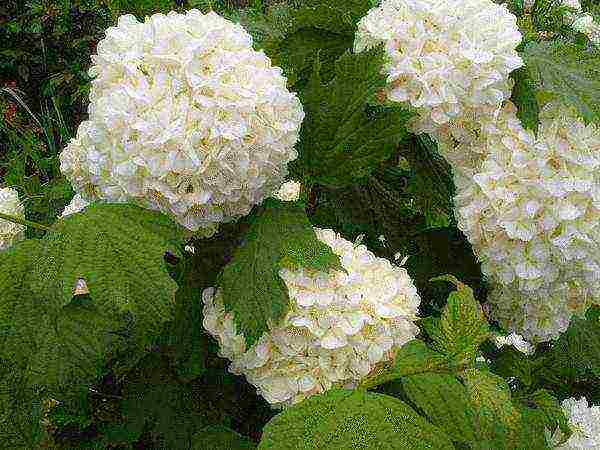
On the southern coast of Crimea, the first viburnum trees bloom very early: from mid-December, but the peak of their snow-white, pink flowering occurs in May, so this month, ignoring the time frame, I tried to collect all the most interesting types of viburnum and tell about their decorative qualities and peculiarities of cultivation. So let's get acquainted.
Kalina avabuki

Japanese evergreen "stately" beauty - Viburnum awabuki, originally from Japan and South Korea. She is tall, up to 4 m and long-lived. The leaves are large, shiny. The flowers are white, collected in loose, drooping inflorescences; bloom in May-June. Bears fruit regularly in September, but yields few viable seeds.
Growing features
Relatively winter hardy species. On the Black Sea coast of the Krasnodar Territory, in severe winters with an absolute minimum of -10-11 ° C, only leaves are damaged to a greater or lesser extent. On the southern coast of Crimea, in cold winters, the ends of annual shoots freeze slightly with the loss of most of the leaves. It tolerates partial shade, but needs a sunny location and moderately moist, fertile, clayey soils for abundant flowering. It is resistant to pests. Propagated by cuttings. Good plant for exotic groups, hedges.
Kalina Barkwood
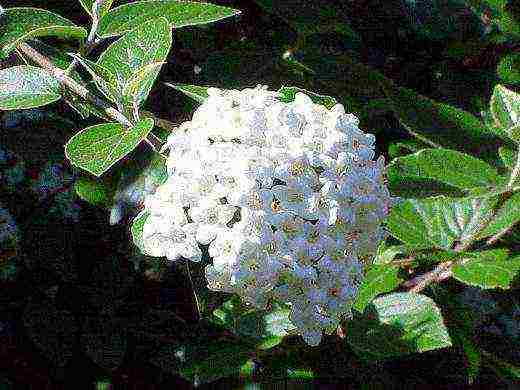
The snow-white beauty (during the flowering period) - Barkwood's viburnum (Viburnum x burkwoodii) is a garden hybrid of Karls' viburnum and useful viburnum. It is a semi-evergreen shrub 2.5 m high and wide. Leaves are longitudinally wrinkled, up to 10 cm long. The flowers are pinkish-white, fragrant, in large umbellate inflorescences, up to 9 cm in diameter. Blossoms in spring; fruits are rarely formed. There are decorative forms.
Growing features
Propagated by cuttings. Prefers light shade and well-drained, fertile soil. A good plant for small groups and close-range tapeworms.
Kalina bodnantskaya
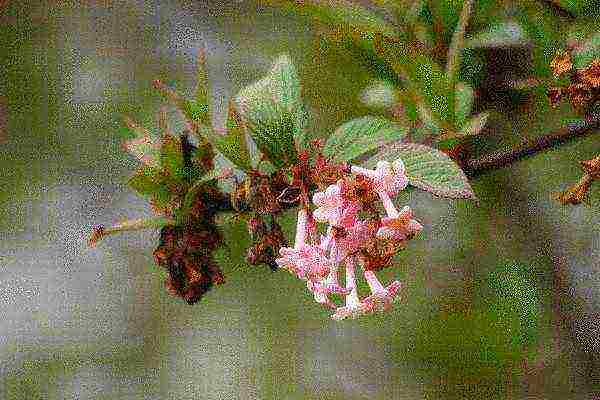
A very difficult to pronounce form is the bodnant viburnum (Viburnum x bodnantense), which, like the previous one, is a garden hybrid, but fragrant viburnum and large-flowered viburnum. It is a deciduous shrub up to 3 m high, grows in breadth up to 2 m. Leaves up to 10 cm long, young bronze. The flowers are light pink, collected in apical plates, up to 7 cm in diameter. Fruits are rarely tied. There are decorative forms, the most interesting among them is ‘Dawn’ (flowers are dark pink, collected in convex corymbose inflorescences, white when flowering).
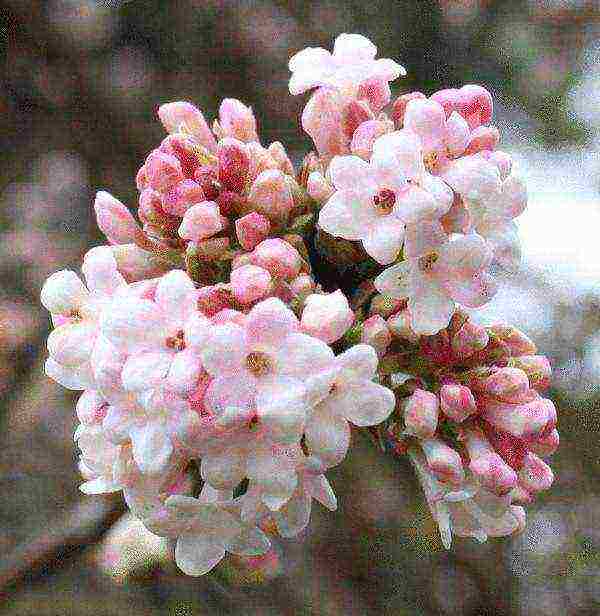
Growing features
Propagated by cuttings. Grows well in full sun and partial shade; prefers fertile, loose soil. Good in small groups in the foreground.
Kalina gordovina

Many famous viburnum gordovina (Viburnum lantana). She is native to Europe, North Africa, Southwest Asia. It is a deciduous shrub 2-4 m high. The leaves are rounded-ovate, up to 12 cm long. The flowers are creamy white with a delicate pleasant aroma, collected in inflorescences - convex umbellate panicles, up to 10 cm in diameter; bloom in May. The fruits turn red at first, as they ripen, they acquire a blue-black color with a light bloom. They are larger than the fruits of other types of viburnum, reaching a length of 12-15 mm. They ripen in September-October and are pecked very quickly by birds.
Growing features
Viburnum of medium growth rate, shade-tolerant, frost-hardy, withstands frosts down to -23-25 ° C (at lower temperatures, leaves freeze over). It tolerates saline soils, is drought-resistant, but grows better with watering.It blooms profusely and bears fruit on fairly moist, fertile, regularly tilled soil. Known for its endurance in a wide variety of conditions. Can be used for single and group planting in open areas and in partial shade. It is slightly damaged by pests. Propagated by seeds, cuttings and layering. Seed germination lasts 2 years. Before sowing, it is recommended to stratify the seeds at 5-10 ° C for up to 3 months. There is information about possible thermal stratification at the same time. Seeding depth is up to 3 cm. One of the most ornamental shrubs with beautiful foliage, inflorescences and fruits, suitable for planting in summer cottages with tapeworms and groups.
Kalina David
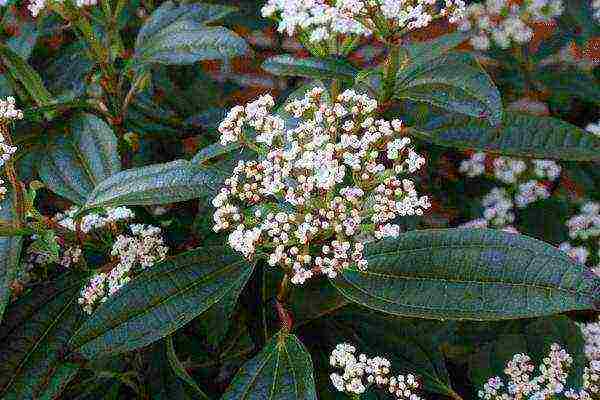
Chinese evergreen beauty - David's viburnum (Viburnum davidii); homeland: Western China. It is a compact, squat shrub, 1-1.5 m high and wide. The leaves are like those of a plantain, up to 15 cm long. The flowers are white, in rare, corymbose inflorescences; bloom in late spring. Rarely bears fruit.
Growing features
Propagated by cuttings. Prefers shady places with moderately moist and fertile soil. An original plant for shady gardens.
Viburnum fragrant
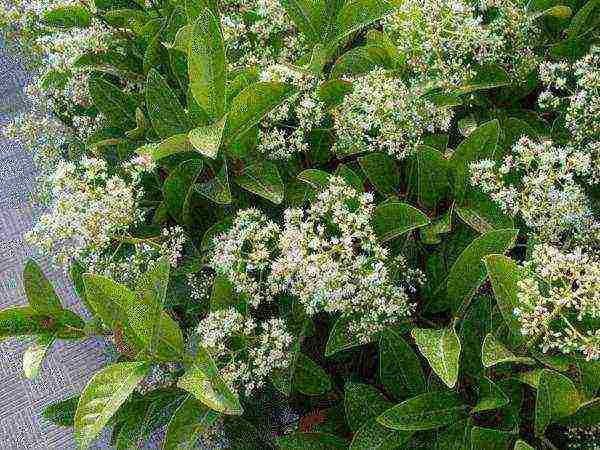
And again, the eastern viburnum - the fragrant viburnum (Viburnum odoratissimum) comes from the Southeast Himalayas, Central China. It is a large evergreen shrub, up to 5 m high and wide. The leaves are thick, glossy, elongated-oval, up to 20 cm long. The flowers are white, fragrant, collected in rounded clusters, 8-10 cm long. Red fruits are rarely formed.
Growing features
Low winter resistance: withstands a drop in temperature to -5 degrees C. Propagated by cuttings. Prefers shaded locations with moist, fertile, clayey, acidic soils. A beautiful plant for small groups and as a specimen under the crowns of tall trees.
Kalina Karlsa
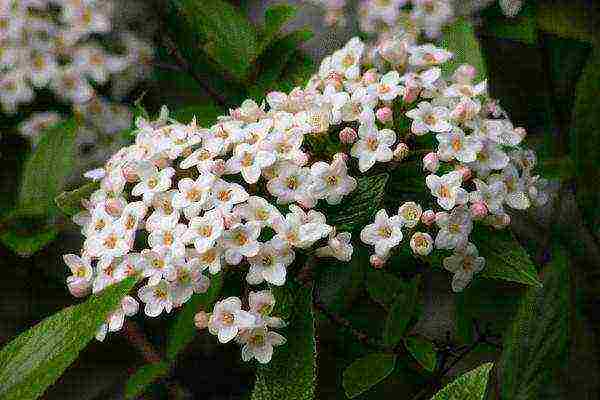
Eastern beauty - Karls' viburnum (Viburnum carlesii); homeland: Korea, Japan. A small deciduous shrub up to 2 m high and wide. The leaves are ovoid-oval, wrinkled. The flowers are white, as if sculpted from wax, collected in rare corymbose inflorescences, with a very delicate scent; bloom before the leaves bloom, in April-May. Fruits are rare. There are decorative forms, the most decorative is 'Aurora' (the bush is more compact, the flowers are pale pink). The fruits are blue-black drupes, ripening in September-October.

Growing features
In eastern Europe, where Karls' viburnum is widely used in landscape design, it tolerates frosts down to -30 ° C. Prized for its fragrant pink flowers in early spring, orange-red leaves and blue-black fruits in autumn. Good in solitary and group plantings. It is not demanding on lighting conditions, but the most lush flowering is observed in partial shade, on fertile, drained soils. It propagates well by grafting on the Hordovina, seeds and cuttings. Sowing in autumn after harvest or in spring with stratification. Without it, the emergence of seedlings is delayed up to 2 years. It is resistant to pests.
Viburnum cinnamon-leaved
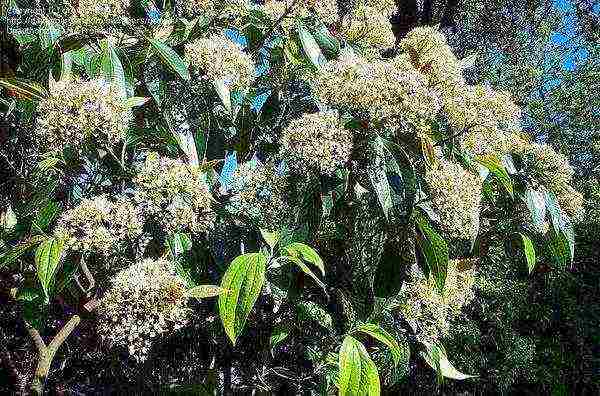
Another Chinese viburnum is cinnamon-leaved viburnum (Viburnum cinnamomifolium), homeland: Western China. This is an evergreen shrub with a loose and at the same time columnar crown. The leaves are not typical for viburnum, they are more like cinnamon leaves: oval-pointed, bent along the central vein, serrate, with arcuate veins, shiny, brownish-green in color. The flowers are inconspicuous, the fruits are rarely formed.
Growing features
Not hardy: withstands a drop in temperature to -5 degrees C. Propagated by cuttings. It is undemanding to light conditions, needs acidic soils. A kind of plant for complex groups.
Viburnum large-headed
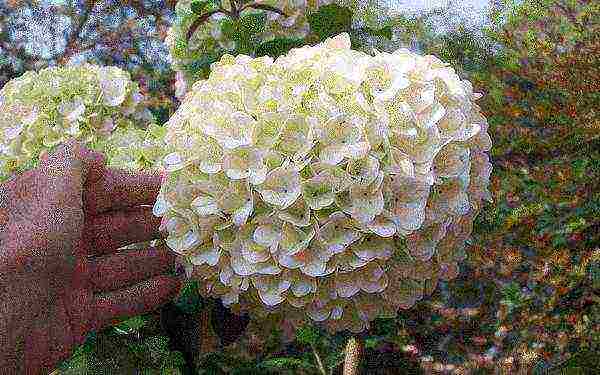
Viburnum macrocephalum, very effective during the flowering period, is a semi-evergreen or deciduous shrub up to 5 m high and wide. This is a garden hybrid. Leaves are ovoid-oval, up to 10 cm long.The flowers are white, sterile (do not set fruits), collected in large, globular inflorescences, up to 15 cm in diameter! The inflorescences are similar to the inflorescences of the Viburnum vulgaris 'Pink'; the same greenish at the beginning of flowering and turning pink when flowering.
Growing features
Low winter resistance: withstands a drop in temperature to -5 degrees C. Propagated by cuttings, but poorly. Prefers light shade and moist, fertile, acidic soils. Spectacular plant as tapeworms and for small groups.
Viburnum laurel, or evergreen

Mediterranean beauty - laurel viburnum (Viburnum tinus), which blooms on the Black Sea coast of Krasnodar Territory and the southern coast of Crimea, starting in winter, in early spring. It is interesting that the ancient Romans called many plants with the Latin word tinus, the leaves of which looked like the leaves of the noble laurel. It is an evergreen shrub, 1-3 m high. Leaves are leathery, sparsely and rigidly pubescent, pointed-oval. The flowers are white, sometimes with a pinkish tinge, collected in flat, corymbose inflorescences, 5-10 cm in diameter, which appear on normally developed plants almost all year round, but the most abundant flowering is observed in winter. Viburnum laurel is one of the most widespread and most stable winter flowers not only in the Sochi region, but also in Yalta. Fruits are oval-pointed, pearlescent blue are always tied in abundance, and in summer this species is a spectacular, beautifully fruiting shrub. There are decorative forms.

Growing features
At a temperature of -15 ° C, it freezes strongly. Drought tolerates well. Propagated by seeds (autumn sowing) or in spring by stratified seeds, as well as green cuttings (under glass) and layering. It develops well with light shading, on fertile, loose, neutral soils. Withstands pruning well, it is perfectly shaped and is used in topiary art. Can be used for solitary and group plantings, curbs and low hedges. In some years, it is severely damaged by the viburnum whitefly, seaside mealy and viburnum bugs.
Viburnum wrinkled
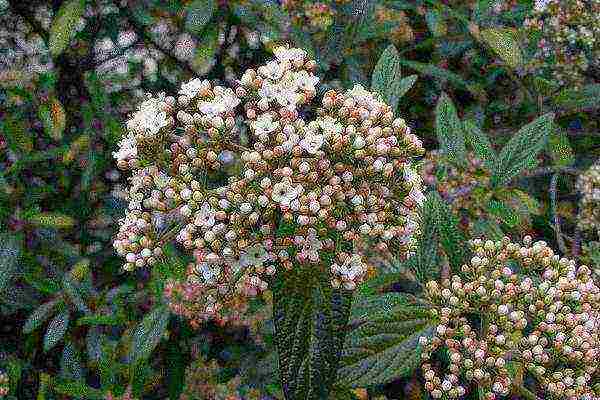
Another Chinese evergreen beauty is wrinkled viburnum (Viburnum rhytidophyllum), homeland: Central and Western China. This is a tall shrub (3-5 m), grows in breadth up to 4 m, with a rather loose, sparse crown. The leaves are large, up to 20 cm long, hanging, with an interesting relief-wrinkled structure. The flowers are small, creamy white, collected in loose, flattened inflorescences, up to 20 cm in diameter; they are decorative and in the bud stage; bloom in April-May. Blackish-purple fruits set well.
Growing features
Requires moderately moist soils or normal watering during growth, semi-shade, sheltered from dry winds, location, neutral soils. It is the most hardy of all evergreen viburnum. Easily propagated by seeds and vegetatively (cuttings). Effective in single and group plantings. It is slightly damaged by pests.
Viburnum ordinary
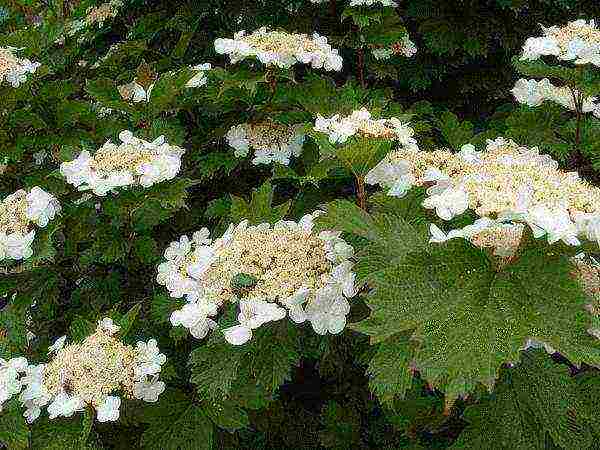
The very famous common viburnum (Viburnum opulus) is native to Eurasia. It is a spreading deciduous shrub up to 5 m high, up to 4 m wide. The leaves are spatulate, large, up to 10 cm long. The flowers are white, in flat inflorescences, the marginal flowers of which are sterile, with relatively large, white petals. Fruits - juicy red berries in loose, flattened clusters; touched by frost, they are edible with a peculiar taste and aroma.
Growing features
Shade-tolerant, moisture-loving, prefers fertile moist soils, but grows on rather dry loamy soils. On the southern coast of Crimea, it suffers somewhat from drought, but blossoms and bears fruit satisfactorily. Quite durable: it can live up to 50 years or more. Propagated by seeds, root suckers, cuttings.When sowing in autumn with freshly harvested seeds, shoots appear in 1.5 years. For spring sowing, a 6-month stratification in wet sand at a temperature of about 5 ° C is required. Seeds are planted to a depth of 2.5-3 cm. Germination rate varies from 40-90%.
It develops normally only on constantly moist, fertile soils, in well-lit places. A beautiful, traditionally favorite ornamental shrub for single and group plantings. Its decorative form ‘Roseum’ is very effective - a form with completely sterile flowers in spherical inflorescences, 5-6 cm in diameter, which are greenish at first, then turn white and pinkish when flowering.
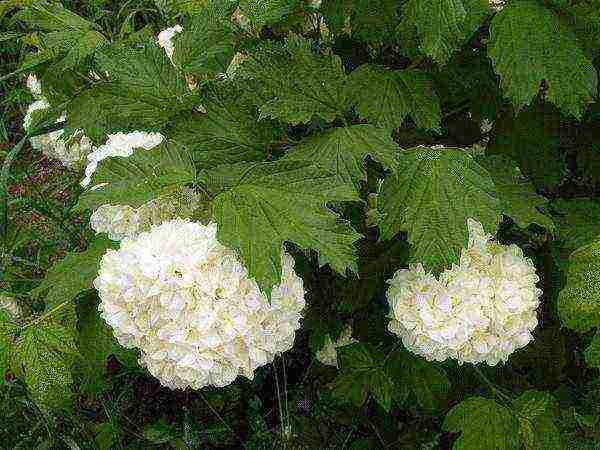
That is why its scientific name is ‘Pink’, while in common usage it is often called ‘Bulldonezh’ - a distorted French name ‘Snow Globe’. This form is less demanding on soil moisture and light. Luxurious viburnum for solitary and group plantings. Severely damaged by black viburnum aphid, rose leafworm. Suitable for planting on slides in groups or tapeworms. The formed standard specimens are very good.
Kalina useful
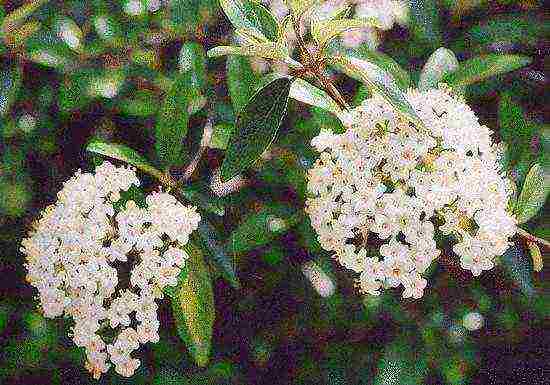
Viburnum utile (Viburnum utile) comes from Central China. It is an evergreen shrub, up to 1.5 m high. The leaves are elliptical-ovate, 2-7 cm long. The flowers are white, fragrant, collected in dense, stellate-pubescent shields, 5-8 cm in diameter; bloom in April-May. The fruits are bluish black.
Growing features
Prefers a semi-shady location, requires improvement of local soil conditions and watering in summer. It does not tolerate a lack of soil moisture, especially in sunny locations: in such cases, shedding of leaves is observed. Suitable for planting along walls, curbs and groups. It is practically not damaged by pests.
Viburnum folded
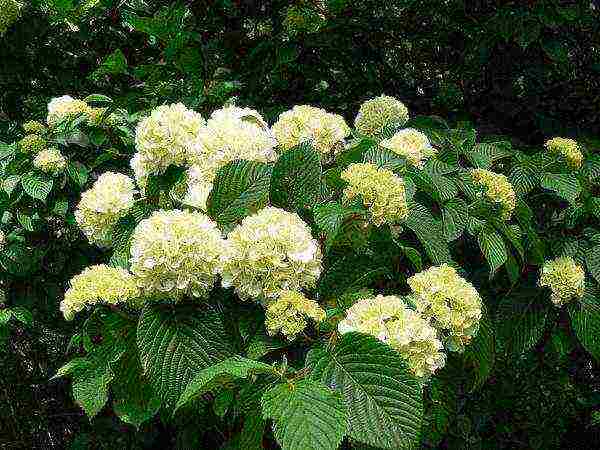
East Asian beauty - folded viburnum (Viburnum plicatum), homeland - China, Japan, Taiwan. It is a deciduous shrub with arcuate drooping branches, 3 m high and 4 m wide. The leaves are ovoid-oval, folded with leaves. The inflorescences are very similar to the inflorescences of the common viburnum, but they are located on the branches in pairs along the entire length of the shoots, which is why this viburnum is very elegant at the time of flowering. Forms fruit rarely. There are decorative forms.
Growing features
Propagated by cuttings. This viburnum is not demanding on growing conditions, but the most lush bushes are obtained when planted in lighted places with fertile, drained soil. A beautiful plant for tapeworms and groups.
Kalina Farrera, or fragrant
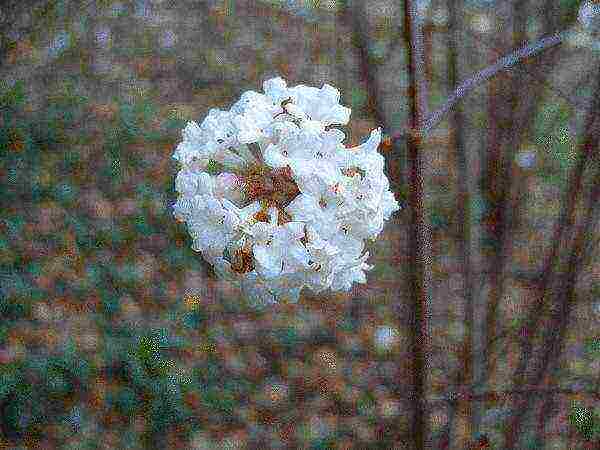
Chinese fragrant beauty - Farrera viburnum (Viburnum farreri, syn.V. fragrans), homeland: North China. It is a deciduous shrub, up to 3 m high and up to 2.5 m wide. Leaves are elliptical, up to 10 cm long. Flowers from white to pink, fragrant, collected in inflorescences, up to 5 cm in diameter; bloom in winter, early spring.
Growing features
It is winter hardy enough: it can withstand a drop in temperature to -15 degrees C. It is undemanding under culture conditions. It is slightly damaged by pests. Suitable for single planting and in groups. For rejuvenation, all old branches are cut at a level of 15-20 cm from the soil surface. Propagated by seeds, layering and cuttings, both green and lignified.
A few facts about viburnums that you did not know yet:
- Have you noticed that the common viburnum leaves resemble maple leaves? Hence the Latin name of the genus Viburnum - the Roman designation of the common maple, which emphasizes the external similarity of the leaves of these two plants.
- Viburnum seeds germinate only after a year with autumn and spring sowing, therefore, late summer sowing is recommended from mid-August.
- Most viburnums have edible fruits, they contain a significant amount of organic acids, vitamins and about 15 different chemical elements valuable for the human body.
- The bark, leaves, flowers and fruits of some types of viburnum have long been widely used in medicine.
- Viburnums are decorative, dust- and gas-resistant, some species withstand drought and salinization of soils, tolerate pruning of branches well, allowing the formation of various types of crowns. They have a high regenerative capacity, therefore they are used to create roadside snow-collecting strips in field-protective afforestation, to consolidate the soils of mountain slopes and as undergrowth to attract birds to plantations.
Placement of viburnum in the country
Viburnums in bloom are so self-sufficient that they can well cope with the role of the May dominant in their summer cottage.
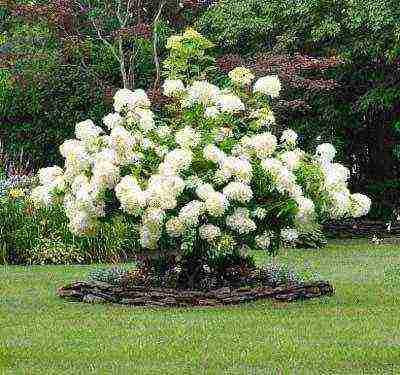
The most beloved viburnum is planted next to the house.
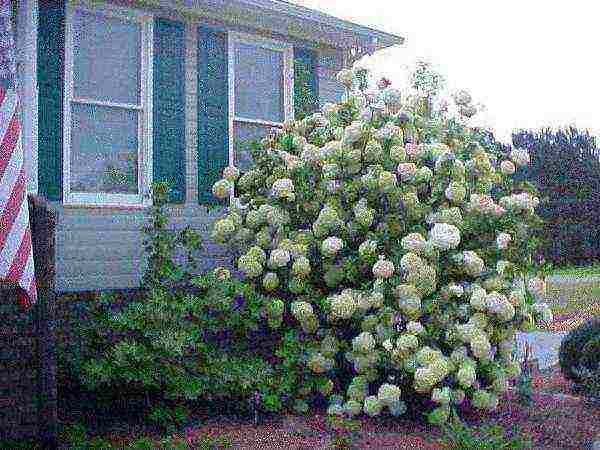
A peculiar arch made of blooming viburnum can even decorate a May wedding.

True admirers of viburnums admire them in the garden.
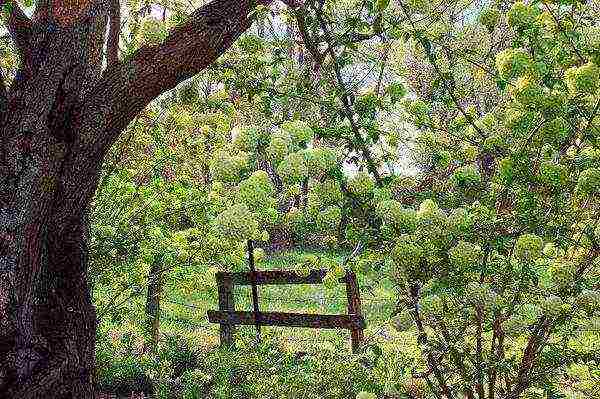
They decorate interiors in May with viburnum bouquets.
